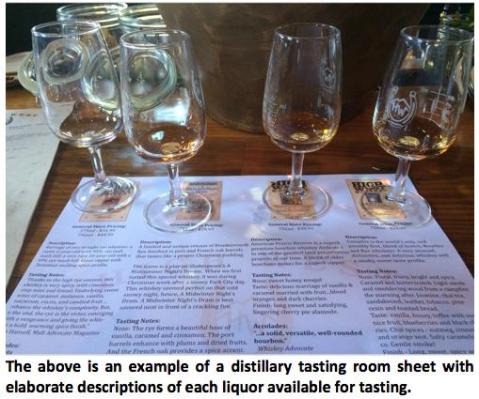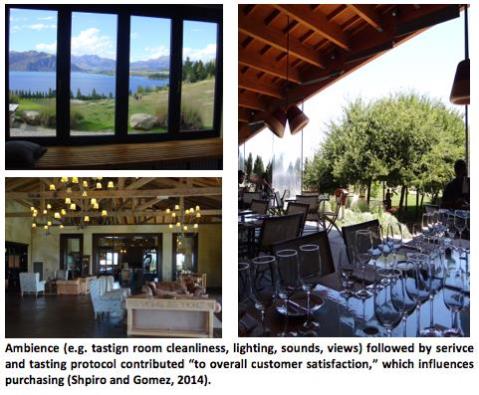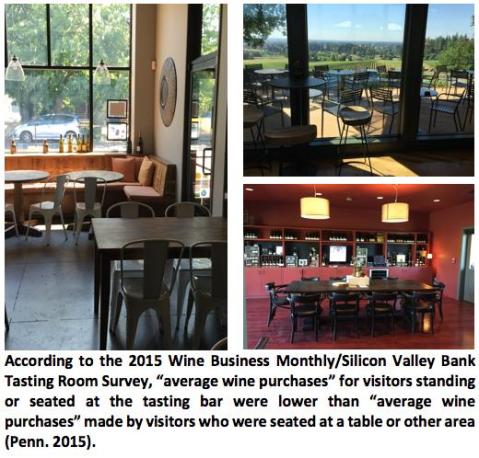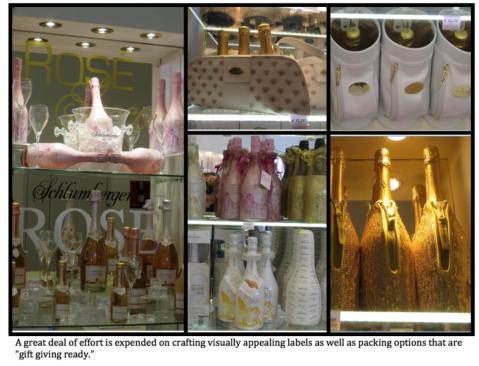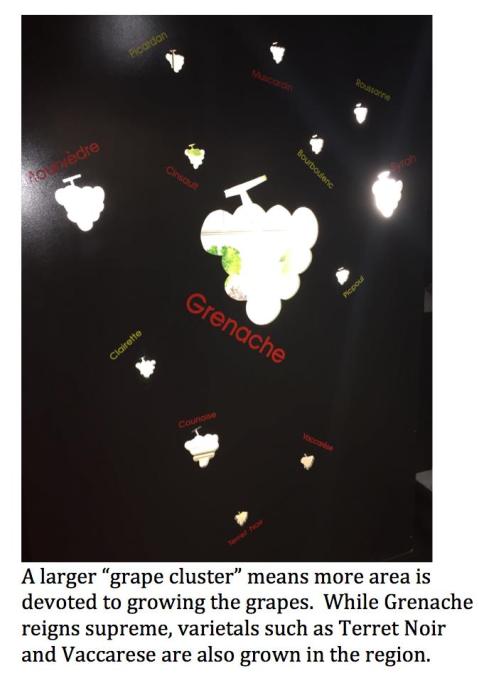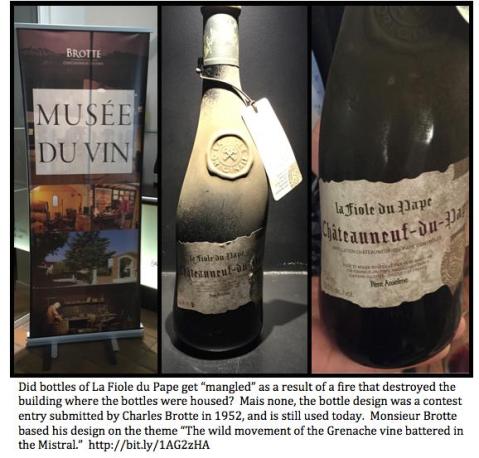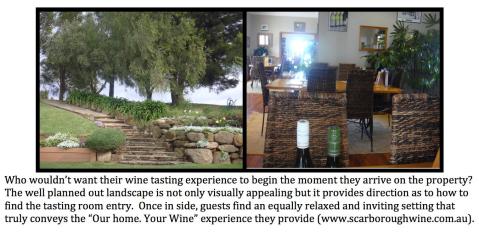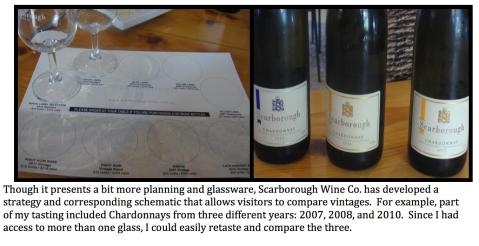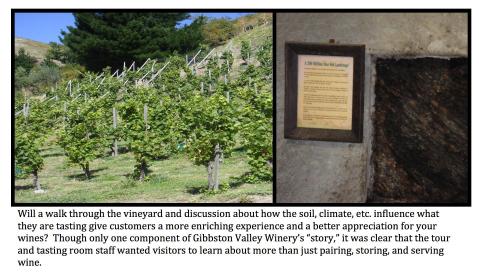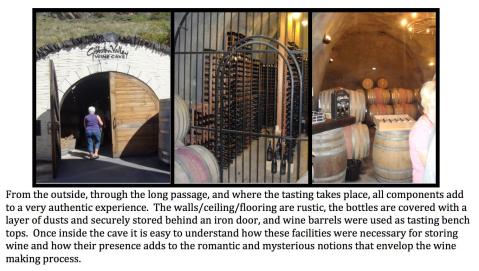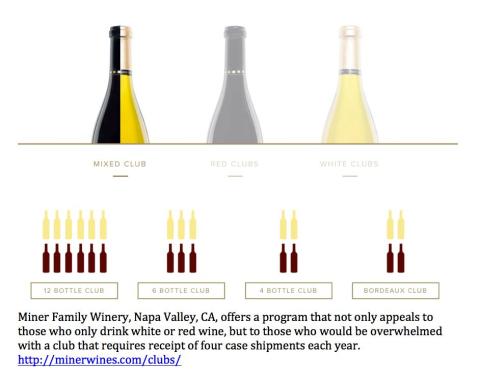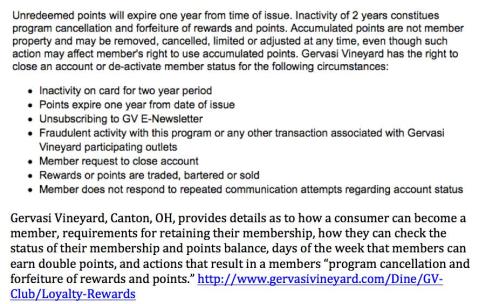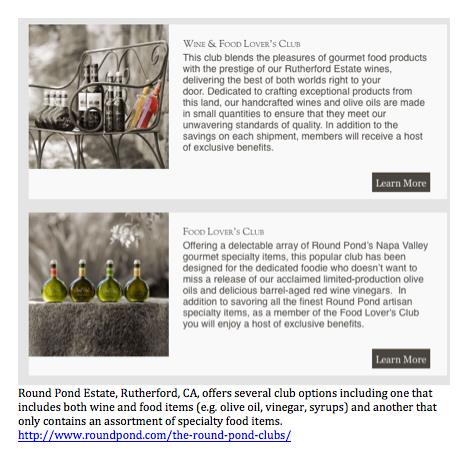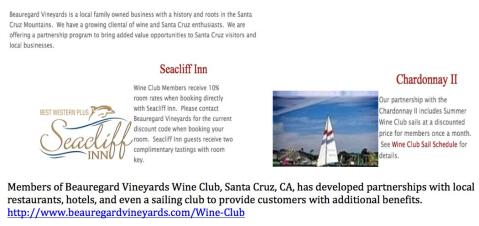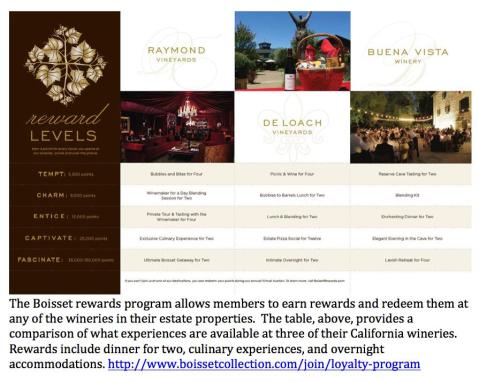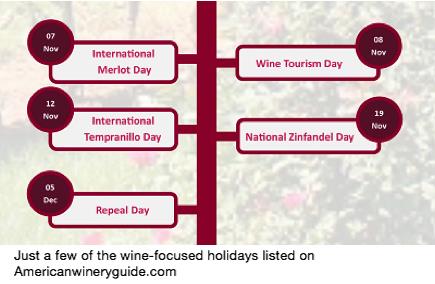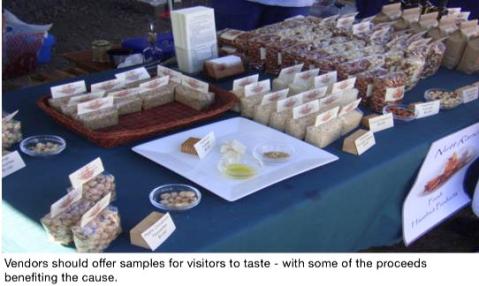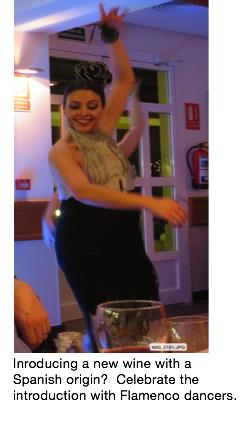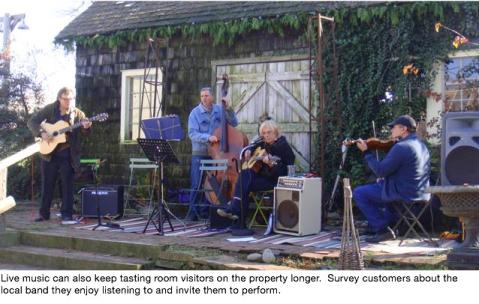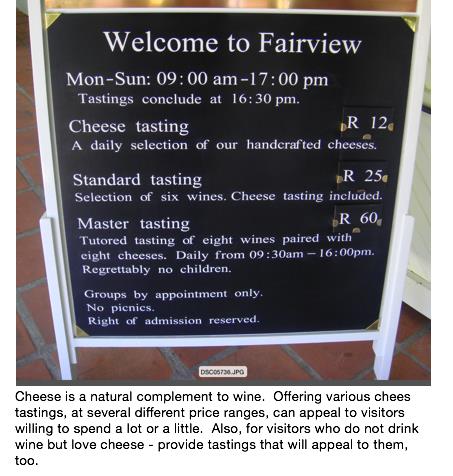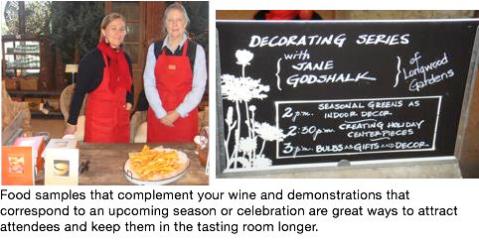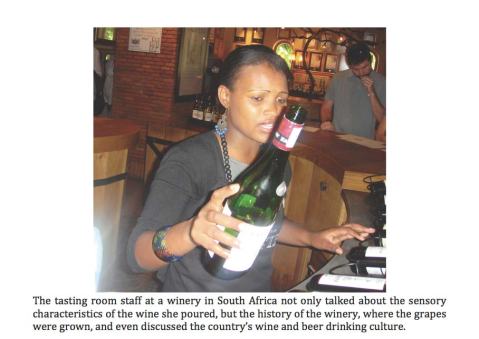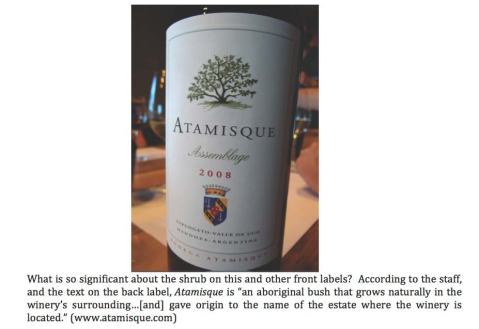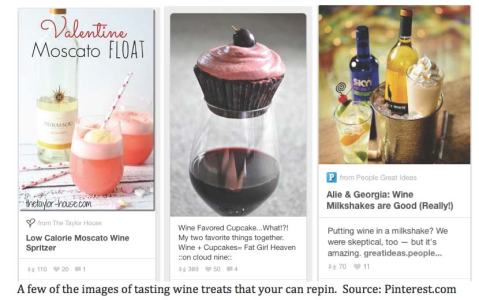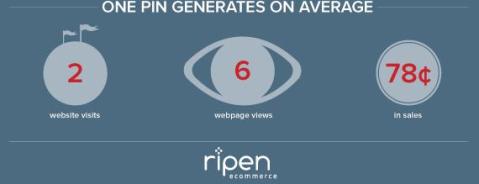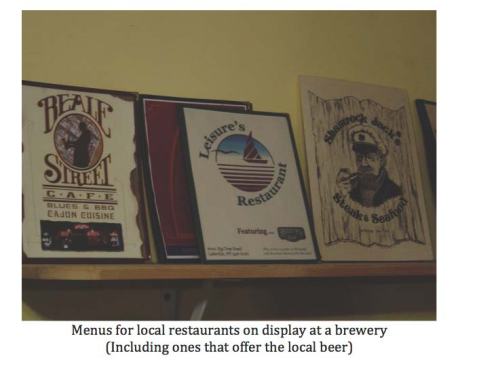Tasting room odds and ends
By: Dr. Kathy Kelley
With just a few weeks until Valentine’s Day and March and April tasting room trail events being planned, you are probably giving some thought to the customer service your staff provides, whether your tasting room sheets might need to be updated, and what constitutes overall customer satisfaction. What I have included in this blog post are highlights of a few marketing studies and some strategies that focus on various tasting room components.
Does your tasting room sheet need a “make under?”
Your tasting room sheet is meant to inform consumers about what to expect from the wine before they sample it, but how much information is too much?
Tomas et al. (2014) conducted a study with seven New York State wineries (two had two tasting room locations) to determine if removing sensory descriptors, defined as “any adjective used to describe the flavor or aroma of the finished wine, both subjective and objective,” would have an impact on tasting room sales (http://bit.ly/1WPpqen).
The researchers provided an example in their article that included the descriptions of the climate where the grapes were grown and what the wine paired with, but eliminated the sensory descriptor: “Dry and full-bodied with decadent flavors of pink grapefruit, honeysuckle and lemon meringue.”
Data from the study indicated that both bottle sales and dollar sales were higher when the modified tasting room sheets were used. The researchers concluded that sensory descriptors “may be intimidating to the inexperienced consumers, who may face further frustration if they try a wine based on its sensory description but cannot recognize the same attributes, or if their expectations are not met” (Tomas et al., 2014). For visitors who have more experience with wine, and “may have existing sensory expectations,” such descriptions may have a reduced “effect…on their choice” of wine.
To charge or not to charge
Now, what about the tasting fee you might charge. Do consumers avoid tasting rooms that charge a fee?
Of the consumers who participated in a 2012 survey conducted in Michigan, 29% indicated that they do “avoid tasting rooms that charge a fee” (http://bit.ly/1KS85eT). The remainder (71%) who did not avoid tasting rooms that charge a fee to taste the wines “purchased an average of 7.68 bottles of wine” with a total of $135.78 spent “over the course of their trip.” Those who avoided tasting rooms that charge a fee reported that they “purchased an average of 6.58 bottles of wine” and spent a total of $97.82 “over the course of their trip.”
Customer service – why it needs to be good
As you well know, poor customer service can cause customers to flee a tasting room quite quickly, but how are consumers’ actions influenced by “good customer service?”
Byrd et al. (2016) surveyed North Carolina winery tasting room visitors about what prompted their visit and how important, on a scale of 1 to 5 (1 = very unimportant and 5 = very important), winery and regional attributes were in the decision to visit a wine region. Eighty-six percent of survey participants rated “good customer service” a 4.39 and “winery staff are knowledgeable about wine” a 4.36, both a which were between “important” and “very important.”
When asked about future actions based on their tasting room experience, 91.2% of those who rated “good customer service” as “very important” responded that they would “likely:” 1) revisit the winery, 2) recommend the winery/vineyard to others, 3) visit any winery in the state in the future, and 4) purchase North Carolina wines. The likelihood of “engaging further with NC wine and wineries” was lower for those who assigned a lower rating to the importance of “good customer service” at the winery.
Is your tasting room experience “all that?”
Have you ever wondered which aspects of a consumer’s tasting room experience contributes to his or her “overall customer satisfaction?”
In this study, conducted by researchers at Cornell University, tasting room visitors rated 24 attributes related to their tasting room experience (e.g. sounds in the tasting room, friendliness of pourer, availability of non-wine gift items) and their overall satisfaction with the visit on a scale from 1 to 5 (1 = poor and 5 = excellent) (Shapiro and Gomez, 2014).
The 24 attributes were combined (based on similarities) into five categories:
1) Ambience (e.g. tasting room cleanliness, lighting, sounds, view)
2) Service (e.g. pourer knowledge, friendliness, appearance)
3) Tasting protocol (e.g. number and variety of wines offered, tasting fee)
4) Tasting experience (e.g. customer’s ability to select wines tasted, waiting time)
5) Retail execution (e.g. wines and merchandise available for purchase, wine quality and price perceptions)
According to the researchers, “ambience” followed by “service” and “tasting protocol” contributed “to overall customer satisfaction” in the tasting room and that “level of customer satisfaction influences the decision to buy, the amount of dollars spent and the number of bottles purchased in a shopping occasion” (Shapiro and Gomez, 2014).
In addition, while their participants’ mean ratings for each of the five categories (e.g. ambience, service, tasting protocol) were between “very good” (a rating of 4 out of 5) and “excellent” (a rating of 5 out of 5), a one-point increase in the “ambience” score (for example, an increase from 4 to 5) increased overall customer satisfaction by 0.25 points.
A one-point decrease in “ambience” (for example, a decreased from 4 to 3) also had an impact as the overall customer satisfaction then decreased by 0.25 points (Shapiro and Gomez, 2014). A one-point increase (decrease) in the ratings for the other four categories resulted in a small increase (decrease) in customer satisfaction.
“Welcome to X Winery. We offer a free winery tour in addition to having some wonderful wines available for you to taste…”
When you visit some big box stores or warehouse clubs you are often greeted by an employee who is checking your membership card, rolling a cart your way, directing you to a department, etc. Part of the strategy is to deter theft, but in 2015, after a three-year hiatus, Wal-Mart brought the greeters back to a select number of store entrances to also “improve the profitability of its U.S. operations by making the stores friendlier…” (http://on.wsj.com/1Jet4MU).
According to a winery consultant, Patty Held, her experience at a winery on a busy Saturday was enhanced by the greeter who informed her about the tasting fee, the gift shop, and other activities she could participate in during her visit. Ms. Held stated in her blog post that when the tasting room is busy, staff are most likely focusing their attention on pouring wines, ringing up sales, etc., consumers who just walked through the door could be “ignored by tasting room staff because they are busy taking care of the other guests” (http://bit.ly/1T8ESDR).
In an upcoming blog, Jen will provide more information on suggested do’s and don’ts for making customers feel welcome – especially during those busy periods.
Sit down and take a load off
Could the addition of seating in your tasting room increase sales?
Based on data collected form wineries that responded to the 2015 Wine Business Monthly/Silicon Valley Bank Tasting Room Survey, “average wine purchases” where higher for those who were seated at a table or area other than at the bar when participating in a wine tasting. If this seated tasting was “private or formal” the average wine purchase was $392, while the average purchase was $107 for consumers who participated in a “casual or group” seated tasting. The average wine purchase for a customer standing at the tasting room bar was $75, while this dollar amount was $65 if the customer was seated at the tasting room bar. In addition, “Seated customers are more likely to join the wine club than if they are standing at the tasting bar” (Penn. 2015).
According to the May 13, 2015 broadcast, 70.79% of visitors purchased wine from the tasting room if they were seated and the tasting was “private or formal” (http://bit.ly/1nbXzdp).
Why is the seated arrangement a benefit compared to standing? The researchers believe that seating allows for personalization, “art of service,” one-on-one conversations, and relationship building between the customer and the tasting room staff (http://bit.ly/1nbXzdp).
Welcome Jen Zelinskie
I would like to introduce Jennifer Zelinskie, the graduate student who is continuing the consumer research funded by the USDA Federal-State Marketing Improvement Program: “Developing Wine Marketing Strategies for the Mid-Atlantic Region” (Grant 11091317). Jen graduated from Penn State in May 2015 with a Bachelor’s degree in Nutrition Dietetics. She has also assisted Denise in previous NE-1020 vintages, in which wines were made at Penn State using several wine grape varieties produced at the North East and Biglerville, PA research vineyards. You can read more information regarding the NE-1020 variety trials here, and the Penn State student winemaking experiences here.
Jen’s interest in wine marketing, and hence some of the questions she will ask survey participants, does include understanding consumer attitudes about wine in relation to their nutritional intake and subsequent consumption and purchasing behaviors. Jen has worked in the past for a winery in the vineyard and in the tasting room. Currently, she is behind the tasting bar at a local cidery and assisting with building the business’s social media presence. In the coming months we will publish blogs that describe outcomes from her recent consumer survey. Welcome Jen!
References
Byrd, E.T., B. Canziani, Y.C. Hsieh, K. Debbage, and S. Sonmez. 2016. Wine tourism: Motivating visitors through core and supplementary services. Tourism Management 52: 19-29. doi:10.1016/j.tourman.2015.06.009
Penn, C. 2015. 2015 WBM/SVB tasting room survey report. Wine business Monthly. 22(7):50-58
Shapiro, M. and M. Gomez. 2014. Customer satisfaction and sales performance in wine tasting rooms. International Journal of Wine Business Research. 26(1):45-60.
Thomas, L., M.I. Gomez, C.J. Gerling, and A.K. Mansfield. 2014. The effect of tasting sheet sensory descriptors on tasting room sales. International Journal of Wine Business Research. 26(1):61-72.
Wine Tasting Room Inspirations
By: Kathy Kelley
Even when on vacation, I’m sure that you make it a point to visit tasting rooms to get an idea of the local “winescape.” I do this as well and I thought I would share some images from a few wineries I’ve been lucky to visit, as well as a few things that attracted my attention. Some of the images and ideas might appeal to you and be applicable for your tasting room. For now, I’ve focused on four different wineries, with more images and examples to come in future blog posts.
Schlumberger, Vienna, Austria
I just returned from a trip to Austria. While in Vienna I made it a point to visit the Schlumberger tasting room (http://www.schlumberger.at/en/home/) where I was able to sample a variety of sparkling wines (at 3 euro for each three ounce pour) produced using the “traditional method” since 1842. The tasting room provides a true educational experience by offering formal cellar tours as well as a free smartphone app (if the visitor doesn’t have a smartphone they can obtain a “player” that they can listen to) that leads visitors through several stations where they learn about the history of the winery, what is involved in making a sparkling wine, how the brand has evolved, etc., followed by a tasting.
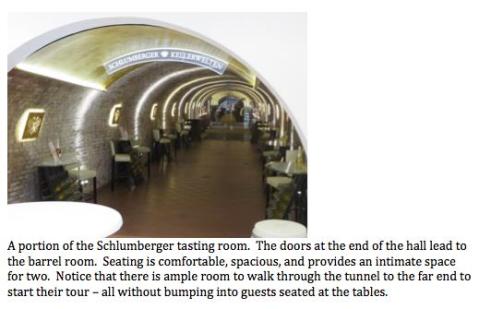 There was a true theme throughout the tasting room. Though the space of the sales area (where bottles and gift items, a small tasting bar, and the cash register were located) was rather “cozy,” the décor was well coordinated with the overall “fairy” theme. Why a fairy? Because, as I was told, sparkling wine has bubbles that are light and airy – and there lies the connection.
There was a true theme throughout the tasting room. Though the space of the sales area (where bottles and gift items, a small tasting bar, and the cash register were located) was rather “cozy,” the décor was well coordinated with the overall “fairy” theme. Why a fairy? Because, as I was told, sparkling wine has bubbles that are light and airy – and there lies the connection.
From the color of the flooring/walls/ceiling as well as the furniture, lighting, music, wine label design, accessories (lots and lots of wine bottle gift packaging options, jellies made from their wine, and fairy shaped cookie cutters), etc., they all supported the concept of opulence and luxury with a hint of whimsy.
The Brotte Wine Museum, Chateauneuf du Pape, France
This entire museum is devoted to helping consumers learn about viticulture and enology. After the 45-minute audio guided tour, which leads visitors through 30+ stations, visitors can sample three wines. But, before reaching the tasting room, there is quite a lot to learn: 1) which grapes are grown in the region; 2) the history of the Valley of the Rhone appellation; 3) terroir (including a discussion of the rocks and pebbles that contribute to this phenomenon); 4) harvest and bottling processes; and much, much more (http://bit.ly/1DUpvD4).
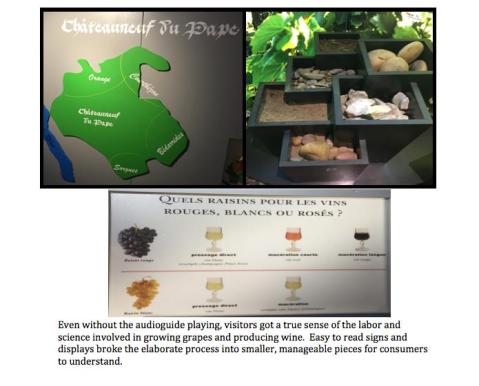 Instead of just providing text that explains that Grenache is the primary grape grown in the region, that Mourvedre is the second most commonly grown grape, followed by Syrah and Counoise, a visual illustrates this point, with the size of the “grape cluster” correlating with the amount of acreage devoted to growing the variety.
Instead of just providing text that explains that Grenache is the primary grape grown in the region, that Mourvedre is the second most commonly grown grape, followed by Syrah and Counoise, a visual illustrates this point, with the size of the “grape cluster” correlating with the amount of acreage devoted to growing the variety.
An entire history is presented, including how the industry in the region has developed overtime and how bottles and labels have evolved. At first glance one display gives the impression that the bottle is quite old – due to the “dusty” appearance and the misshaped glass bottle – but the shape and appearance were purposely developed by Charles Brotte in 1952 for a local contest. Whether it is the perceived “age” of the bottle or the actual story, most likely all who see the display (and, hopefully, taste the wine) will remember it well after they return home. A bonus for the winery as the bottle can be easily picked out from the massive lineup that crowd liquor store shelves.
Scarborough Wine Co., Hunter Valley, Australia
From the time arrived at the property, until I departed, I noticed a great bit of attention to detail and thought given to guest comfort at Scarborough. Well before guests step into the tasting room they are surrounded by well planned gardens and entryways – pretty much setting the stage for the experience that awaits in the tasting room. With individual seats placed around several tables in the (rather large) tasting room, we were able to have our own space, taste at a leisurely pace, and discuss the wines privately. While they do have the advantage of a fair amount of square footage to place tables and chairs, a smaller space could include a few “two top” or “four top” tables (seating for two and four visitors, respectively) and a more “space efficient” tasting bar (without chairs in order to maximize the number of visitors that can be served).
During my tasting at Scarborough Wine Co., I was provided with five wine samples at once (three Chardonnays, 2007, 2008, and 2010 vintage, and two different Semillons). This system could very well be cumbersome for the tasting room staff; however, it was well managed. After they seated us they provided the schematic (in the image below), a written description of the wines, all five samples, and a complementary tray of cheese, meats, crackers, and dried fruits. The tasting room staff stopped by frequently to answer questions and assist us in selecting the wine that we subsequently purchased. While some tasting room visitors might like each sample to arrive individually and have a continuous conversation with the tasting room staff, others might prefer the pace and “freedom” of this tasting.
Gibbston Valley Winery, Queenstown, New Zealand
With three different tour options (wine cave tour, $15.00 per person; cave tour select, $30.00 per person: and prestige wine tour, $175.00 per person), two different wine making experiences ($225 per person and the other based on participant experience), a full service restaurant, chees shop, wine shop with a variety of accessories, and more (http://www.gibbstonvalley.com/), there are quite a few things to encourage consumers to visit Gibbston Valley Winery and keep them on the property for more than a quick tasting.
The basic wine cave tour took place mostly in the vineyard (with a three sample tasting in the wine cave afterwards) and focused quite a bit on how and what grapes are gown in the region, the use of yards and yards of netting to minimize bird damage, a bit of history about phytophthora in the region, and the importance of terroir.
Though the discussion included a description of what to expect from each glass and appropriate food pairings, a great deal of effort was made to educate visitors about the actual production process in order to convey that what we were tasting was truly unique. Even between samples we were reminded that what we were tasting was influenced by the “200 million year old landscape,” as noted on the plaque on one of the walls.
While each of these tasting rooms are unique and may have some advantages that your tasting room might not have (e.g. ample space for several individual tables, authentic wine cave) it is possible to enhance your visitors’ experiences by implementing some of these ideas.
While you may not have the budget to purchase museum quality displays, you probably know an artist who could take text that explains a process or wine component (e.g. residual sugar) and create an engaging and informative image to hang on the wall (e.g. a drawing of a scale that helps explain residual sugar and how the concentration differs between dry, off-dry, and dessert wines). You may not have an overall theme for your winery, but if developed could this enhance the overall “sensation” that a visitor gets when at your tasting room? Perhaps fairies are not appropriate for your winery and tasting room, but another object, destination, or feeling might serve as the basis for your planning and tie all the tasting room components together. The possibilities are endless.
Events, Part 1: Planning
By: Kathy Kelley
With the fall and winter holidays coming up, I’m sure you are in the midst of planning, or have finished planning, a few events that will draw consumers to your tasting room. But, surely, November, December, and early January are not the only months during which you’ll host such events. Consider creating events that will bring customers to your tasting room during times when sales are typically slow. An opportunity to develop and host an event is only restricted by your creativity and rationale for offering the event. Some potential events include:
- Store openings and anniversaries
- Recognition of customers who spend the most at the business on an annual basis
- Targeting your primary customers for a “night out”
During what other times might you host an event? Some to consider:
- October is Pennsylvania Wine Month – 31 days of celebrating
- Pre- or post-harvest celebrations
- End of bottling
- National Drink Wine Day (February 18th; nationaldrinkwineday.org), not to be confused with National Wine Day (May 25th)
- You will find a nice calendar of events on Americanwineryguide.com. Mark you calendars for “World Moscato Day” (May 9th), National Chardonnay Day (May 21st), “Drink Local Wine Week” (Oct. 11th through the 17th), and many more.
Events for a cause
An event may be the perfect way to raise money for a charity or alert the community about a cause. Several examples exist where retailers host an event on their property, invite artists to showcase and sell their paintings, jewelry, etc., and provide space for caterers and food businesses to promote their products.
Having caterers at the event is a great way to help customers discover more way to use your wine. Ask that caterers share menus of what they plan to serve with you well in advance – then post a small sign by each tasting station that lists which one of your wines pairs well with the dish. Alternatively, you could create “handouts” that list the item(s) at the food station, contact information for the vendor who is selling the product/providing samples, the name of the wine that would pair well, and how attendees can order/find your wine locally (at the winery, whether your wines are at state liquor stores, if you sell your wines at farmers’ markets, if the wines are available at local restaurants, etc.), as well as you contact information, how they can join your case club, and related information.
If you don’t already have a list of caterers who could handle a crowd, consider visiting a local farmers’ market and connect with food vendors. If they have been selling goods at the market for a while they probably have a following and they could easily promote the event at their farmers’ market stall, via social media, etc. Having another artesian from the community can further enhance the “local” aspect of your business and that you do your best to support other small businesses.
While a free event might draw a reasonable crowd, selling tickets could help defray the costs of the event or provide a significant amount that could be donated to the cause. Also, if tickets are sold in advance, it will be much easier to plan the event and ensure that enough food and drink is available.
Ask artists to donate some of the proceeds from goods sold, provide items for a silent auction, or pay for their vendor space. Even though attendees will pay admission and bid on items – set up several sites where they can donate money. Asking vendors to have a “donation jar” in their booth is one way to collect spare change and dollars.
What to consider when planning an event
With the amount of time and energy that developing and implementing a successful event can take, consider holding the event for more than one day. Of course, the number of days that you hold an event depends on the type of event as well as how established the business is and how many customers could potentially visit.
More established tasting rooms with a larger customer base may need to host a multiday event to accommodate the number of visitors expected. Though having enough employees available to complete all the prep work and on-site activities can be difficult, consider the potential benefits, including:
- Increased likelihood that busy couples and groups of friends could attend at least one of the days
- Flexibility in arranging times for vendors, demonstrations, and specialty guests
- Reduced parking congestion and crowding
Before you start planning, take stock of the amount of property or space available inside the tasting room to accommodate larger-than-average crowds. Additionally, determine whether you will need an overflow-parking site.
- Do you have an open field, or can you use another business’s parking lot?
- If so, can attendees walk from this parking area to the event, or will you need to hire buses to transport them?
Hire extra staff to organize these spaces most efficiently and alleviate stress for all involved. Extra staff may also be necessary to enforce food and guest safety, as well as to help prevent vendors and guests from being victims of theft.
Even with significant space available to accommodate a crowd, several components of creating a comfortable space still need to be considered, such as:
- Appropriate number of bathrooms and wash stations
- Variety of refreshments available for visitors to purchase, especially if temperatures are unseasonably warm
- Shelter, such as a tent, in case of inclement weather
Consider offering tents or other outbuildings to food vendors who will be cooking and selling snacks and meals. Tents for cooking must be up to code and need to be placed a specific distance from permanent buildings in case of fire in the tent. Consult your local township, borough, or city for more information and a list of restrictions.
Will your event be “worth it?”
The ultimate goal of the event is to generate income while offering your visitors an experience. Hence, you’ll likely need to devote resources beyond what you allocate for regularly scheduled promotions. When both planning and evaluating the event, develop a list of questions that can guide you through the process and help you determine what to change for future years. The following are some questions worth considering.
Is the idea unique?
An event can help business owners differentiate themselves from their competitors. The uniqueness, and subsequent consumer appeal, of an event can be a key marketing factor that customers associate with the business. Certainly, there is a difference between a unique idea that is engaging and inviting and a unique idea that is over the top and intimidates visitors. To be effective, as well as interesting, some tie-in needs to be established between the business and the focus of the event. For example, if you hire a local artist to design labels for your wines, consider a “meet the artist” night during the event.
To achieve this, tasting room staff should ensure that the perception (what actually happens) of the event is greater than what visitors expect, and that the outcome ultimately “wows” attendees. Another way to think about this is to deliver more than what is promised, and the visitor will not be disappointed. The reward may be realized both during the event and when the visitor returns.
Is the event important enough to justify the amount of time and expense invested?
As can be expected with creating an event that is both unique and memorable, resources need to be allocated to the effort. Sales and foot traffic (discussed in next week’s blog post) are two indicators you should track and analyze. Keep in mind that it may take more than one attempt at offering the event to actually obtain the desired level of profitability.
Customer interaction
Once attendees have arrived, involve them in an experience that engages each of their senses.
- Sight: As mentioned above, create spaces for local artists to display their products
- Sound: Set up a stage and invite local bands to perform or play a selection of music from CDs you/they offer for purchase. Have appropriate seating, or space for visitors to set up their own chairs, for more formal performances when artists are asked to entertain rather than just play “background” music. Don’t forget to publish a list of performances and ask the band/performer to do the same
- Touch: Allow attendees to walk through the vineyards, see the vines up close, and pick fruit right from a few vines you’ve set aside for this purpose
- Smell and taste: Invite a local bakery to sell specialty breads, pastries, and cheese, all complementing your wine. Nothing smells better than freshly baked bread (except wine of course!)
Research has shown that the longer consumers spend looking at merchandise in a store, the more likely they are to make a purchase. If you already offer barrel-tasting tours, vineyard tours, and reserve-in-advance tastings, consider other ways you can educate visitors. Try implementing a mix of short seminars for free (e.g. how to properly cellar wines) and all-day educational sessions for a fee that involves the customer, and that quite possibly provides them with something they take home from the session (e.g. making jelly from wine grapes).
Depending on what you talk about during the seminars, you may alert them about products and wines that you sell and that they might not have considered or noticed before hearing you speak.
Co-hosting events
Though your business may develop the vision for an event, the responsibility of coordinating and implementing it doesn’t need to be restricted to only you, your facility, and your staff. Involve a complementary business, or two, and work together.
For example, invite a local baker, caterer, cheese producer and/or florist to co-host. During the event, staff from all three businesses could offer demonstrations, such as meal preparation using the food items and choosing a flower arrangement for the table. Each business could also provide goods that can be included in gift baskets for sale, part of a charity raffle, or that could be ordered at the event (great for those who might need winter holiday gift ideas).
Consumers who attend the event may appreciate being able to interact with more than one business and purchase goods and services provided by each. Combining forces could be more economical for all businesses involved, compared to each business hosting its own, smaller event.
Hosting an event together also results in having a greater number of employees available to staff the event, along with pooling funds to cover advertising and event-related expenses. Along with agreeing on a unified theme that makes sense for all businesses involved, decide in advance how you will assigning duties and distribute profits from either admission or activity fees, as well as how the visiting businesses compensate the host business for utility and land use.
When it comes to social media, make sure that you:
- “Like” the business you co-host with on Facebook and follow them on Instagram (Abigail Miller will be discussing Instagram in her December 12th blog post).
- Alert followers when you add co-hosts’ products to your displays or when new partners and vendors agree to be involved in the event
- Post images before, during, and after the event. Consider assigning that duty to a specific staff member – most likely if this role isn’t assigned the number of images collected and items posted will be less than desired
- Both original tweets and your retweets should mention your co-hosts
- Develop a Pinterest page that all businesses co-manage and pin pictures to related to the event, provide links to recipes for foods served during the event, etc.
- Develop a #hashtag specifically for the event and use it in all your postings. Also, ask visitors to use the #hashtag in their postings so that you can search for their images and repost on social media sites, websites, and tweet. You could encourage attendees to help document the event by announcing that you will hold a contest and select (at random or by vote) one or two visitors who post and use the #hashtag.
All these efforts inform your customers about joint activities while reminding them about your business.
In next week’s blog, I’ll provide information on how to evaluate your event and determine whether it was a success.
Tasting Room Techniques
By: Kathy Kelley
You, me, and the others who write for this blog are all drawn to winery tasting rooms, and many times we plan our vacations around wine related activities. I’ll bet you incorporate what you observe at other tasting bars into what you say or do when you pour samples in your own establishment. You probably also make a mental list of what “doesn’t work so well” and try to avoid such issues. Certainly you cannot always anticipate what is going to happen in your tasting room, but you probably have experienced an issue or two that could be handled more seamlessly in the future with a little preplanning.
Getting into a groove with groups
I’m sure that you have had your share of groups stop by unannounced, hoping to get served right away, and then be on their way to the next tasting room. You probably have also received several calls from consumers asking if your space can accommodate larger groups. I recently overheard one seasoned staff person tell a caller, “Sure, they can come and taste, but we are really busy and there might be a wait…..”
True as this is, how welcome would you feel if you were the person making the telephone call? I got a good sense that the tasting room staff person who took the call would have just been fine if the party didn’t show up – as the owner, would you? Since large groups of visitors can be hard to avoid, consider developing a set tasting menu of four wines (two of your best selling sweet and two of your best selling dry wines), for groups of five or more. This would allow your tasting room staff to have a bit of control over the situation.
You could even employ this strategy for those who visit your tasting room and have no idea what wines to sample. Certainly, they could go in order of sweet to dry but what if they need to select just four or six samples from a list of 12 or more? Sometimes consumers get overwhelmed by choice and then confused (and sometimes embarrassment) because they don’t want to make the wrong choices. A few “mini” tasting tracks (one sweet, one dry, and one with a little of both) and corresponding tasting sheets could be used in this instance.
What questions do you commonly get asked?
We are entering a time when you are probably relying on part-time help or training new tasting room employees so that you can be out in the field or in the winery. So, they may not know (or have completely learned) about some of the more basic or historical facts about your business, such as how the winery got its name or how long the winery or tasting room has been in existence. As surprising as it may be, I have heard even the most polished and impressive tasting room staff stumble when responding to these questions.
This issue can be resolved by asking your staff to develop a list of questions they get asked and then you can create responses for a FAQ list that they can refer to and learn from. Topics could include:
- Origin of the winery’s name and year founded
- How many bottles or cases are produced annually
- Vineyard acreage
- Grape varieties grown on the property and where other grapes used to make the wines are grown
- How the wine bottle labels were selected, what your winery’s logo means/its significance, and how the owners select the name for their blends
- How the winery got started. For, example, did the owner receive training in a prestigious wine grape growing region? Or, is the owner so passionate about wine that he/she completely changed his/her occupation in favor of becoming a member of the wine industry?
What new and/or projected food trends does you wine pair with?
A strategy that I talk with students in my Penn State course about often, especially when focusing on edible products, is to provide consumers with may ideas/ways to use products in order to encourage them to purchase greater quantities and/or increase purchasing frequency. You may have a recipe for mulled wine or sangria, which would list your wine as the primary ingredient, but could you take it a bit further?
Do you remember back in March of this year when a particular chain restaurant made headlines because they had added “wine” milkshakes to their menu (usat.ly/1rOmwfS)? Well, the article attracted a bit of attention and several recipes were developed and posted on food and wine websites.
You do not need develop your own unique recipes in order to make the suggestion that your wine be the basis for a milkshake or other tasty treat. While you or a staff member may have a culinary background or just like to be creative in the kitchen, I would encourage you to take advantage of what is already available on Pinterest.
Just as with Facebook, Twitter, and the other social media accounts you employ, if you are on Pinterest you need to pin/repin images and video regularly. With all the content posted on Pinterest, repining an image to your winery’s Pinterest page is one way to inform, remind, persuade, and build relationships with consumers. According to recent research, “One pin generates on average: two website visits, six webpage views, and 78 cents in sales” (bit.ly/1qgCsp4).
What else can you do to encourage increased usage? Suggest several pairings, of course. When you think of the foods that your wine pairs with – are you thinking more broadly than just steak and fish? For example, could you provide pairing suggestions for current food trends?
We are still a few days away from the first day of fall, but it is not too early to think about which of your wines pairs well with pumpkin. Pumpkin has a few things in its favor: “a perennial favorite,” national chains creating pumpkin flavored foods and beverages (e.g. Starbucks and McDonalds), and “pumpkin-flavored sales jumped 14 percent to about $308 million in 2013” (bit.ly/1xg8DcV). 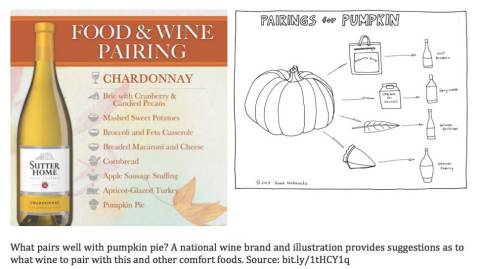
What if pumpkin flavored foods do not appeal to consumers? Foods projected to be trendy for fall and into 2015 include kimchi and fried chicken (bit.ly/1uCaJ1t), and salamis are predicted to be the “next bacon” (avc.lu/1lCJJPz). I’m sure that you could come up with some pairing suggestions, and have fun doing so.
Where are you going to direct visitors after they finish their tasting?
Most likely, tasting room visitors who come to your establishment from remote locations are going to send a few hours or even days in your region. These visitors probably need to eat lunch or dinner before continuing their travels, so why not direct them to restaurants that serve your wines?
These travelers may not be very familiar with the region and, if they trust you enough to buy your wines, they will most likely value your recommendations for restaurants and other businesses that they should also visit.
Aside from the verbal recommendation, what else could you do to help them make the decision to actually visit the restaurant and enjoy a nice meal along with a glass of your wine? How about having a menu from each of these restaurants in your tasting room?
Did you give them a reason to come back?
A tasting room guest’s premier visit should (hopefully) not be their only visit. So, what can you do to get them to return? Give them some reasons to return by sharing information about events and festivals that they can attend at the winery and contests host, with some prizes needing to be claimed at the winery.
Conveying this information might be a little bit difficult when your tasting room is packed with visitors, but it is still possible to alert customers about the barrel tasting you offer in the spring, your winter holiday open house, etc. Do you have space on the bottom of your tasting room sheet with a summary of upcoming activities? Or, do you have room on the back of the tasting room sheet for a calendar of upcoming events, list of outlets where your wine can be purchased, as well as restaurants that serve your wines?
Even though you may post announcements on your front door and place pamphlets on a table in the entry, the tasting bar might actually be the best place for some of these items. With customers lingering longer at the tasting room bar than they might at your entry – they may be more likely to pick up a flyer and read it. This also serves the purpose of occupying customers as they wait for their next sample to be poured.
If your visitor is on Facebook they can look at pictures of the previous year’s event and read your post: “We had a great time this year celebrating with all our fantastic customers at our holiday open house. We will post the dates for next year’s event in early October.” I know that I would mark my calendar!
Do you have suggestions for marketing topics that could be the focus of future blog postings? If so, please email your suggestion to me at kmk17@psu.edu

